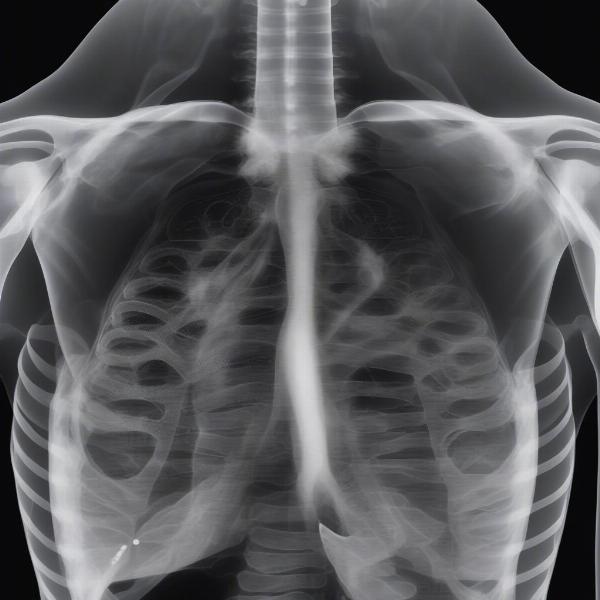Aspiration pneumonia in dogs is a serious condition that occurs when foreign material, such as food, vomit, or liquid, is inhaled into the lungs. This can lead to inflammation and infection, causing a range of respiratory issues. Radiographs, commonly known as x-rays, play a crucial role in diagnosing and managing this condition. Understanding what to look for on a dog’s radiograph can be invaluable for pet owners navigating this challenging diagnosis.
What Does Aspiration Pneumonia Look Like on a Dog’s X-ray?
Veterinarians use radiographs to visualize the lungs and identify the characteristic signs of aspiration pneumonia. These signs often appear as an alveolar pattern, signifying the affected air sacs within the lungs. The affected areas might appear more dense or opaque than healthy lung tissue. The location and distribution of these changes can indicate the severity and extent of the pneumonia. For example, a dog that aspirated while lying on its side might show more pronounced changes in the lower lung lobes.
 Dog X-ray Showing Aspiration Pneumonia
Dog X-ray Showing Aspiration Pneumonia
Recognizing these patterns requires professional expertise. While pet owners might be anxious to understand their dog’s condition, it’s vital to rely on a veterinarian’s interpretation of the radiographs. Misinterpretation can lead to incorrect treatment and potentially worsen the prognosis.
Different Radiographic Patterns in Aspiration Pneumonia
The radiographic appearance of aspiration pneumonia can vary depending on the material aspirated, the chronicity of the condition, and the individual dog’s response. While the alveolar pattern is a common finding, other patterns might also be present, such as a bronchial pattern. In some cases, a mixed pattern is observed.
The type and distribution of the aspirated material influence the radiographic findings. For example, the aspiration of gastric contents might produce a different pattern compared to the inhalation of water. The timing also plays a role; acute aspiration pneumonia might look different than chronic cases where scarring or abscesses have developed.
Interpreting Your Dog’s X-ray: A Veterinarian’s Perspective
Dr. Emily Carter, DVM, a board-certified veterinary radiologist, explains, “Radiographs are a critical tool in diagnosing aspiration pneumonia. While owners can gain a basic understanding, accurate interpretation requires specialized training. We look at a combination of factors, including the distribution of the changes, the severity of the opacity, and any accompanying pleural effusion.”
How Can X-rays Differentiate Aspiration Pneumonia from Other Respiratory Issues?
Radiographs can help differentiate aspiration pneumonia from other respiratory conditions like bronchitis, pneumonia caused by infections, or even alveolar pattern in dogs. However, additional diagnostic tests, such as blood work, bronchoscopy, and tracheal washes, may be necessary for a definitive diagnosis and to identify the underlying cause of the aspiration.
Treating Aspiration Pneumonia: Beyond the Radiograph
While the radiograph helps diagnose aspiration pneumonia, it’s crucial to remember that it’s only one piece of the puzzle. Treatment typically involves a combination of antibiotics, supportive care (oxygen therapy, fluid therapy), and addressing the underlying cause of the aspiration. In some cases, surgery may be necessary to remove foreign material or address anatomical abnormalities like a hiatal hernia dog.
Dr. Carter adds, “Early diagnosis and aggressive treatment are key to a positive outcome. Regular monitoring with repeat radiographs is essential to assess the response to therapy and ensure the pneumonia is resolving.”
Conclusion: Radiographs are Essential for Diagnosing Aspiration Pneumonia in Dogs
Aspiration pneumonia is a serious condition that demands prompt veterinary attention. Radiographs play a crucial role in diagnosing and managing this condition by providing a visual representation of the lungs. While understanding the radiographic findings can be helpful for pet owners, professional interpretation is essential for accurate diagnosis and appropriate treatment. Early intervention and a comprehensive treatment approach are critical for a successful recovery.
FAQ:
- What are the common signs of aspiration pneumonia in dogs? Coughing, difficulty breathing, increased respiratory rate, lethargy, and loss of appetite.
- Can aspiration pneumonia be fatal in dogs? Yes, it can be life-threatening, especially if left untreated.
- How long does it take for aspiration pneumonia to show up on an x-ray? Changes might be visible soon after aspiration, but sometimes it can take a few days for the characteristic patterns to develop.
- Are there any home remedies for aspiration pneumonia in dogs? No. Aspiration pneumonia requires professional veterinary care. Home remedies are not effective and can delay necessary treatment.
- How can I prevent aspiration pneumonia in my dog? Careful feeding practices, especially for dogs prone to regurgitation or vomiting, can help. Consult your vet about preventative measures for at-risk dogs.
- What is the prognosis for dogs with aspiration pneumonia? The prognosis depends on several factors, including the severity of the pneumonia, the underlying cause, and the dog’s overall health.
- How much does a dog x-ray cost? The cost varies depending on the location and the complexity of the procedure. It’s best to contact your veterinary clinic for specific pricing information.
ILM Dog is your trusted partner in dog care, offering expert advice on everything from breed selection to health, training, nutrition, grooming, and more. We connect dog lovers worldwide with reliable, practical information, helping them provide the best possible care for their canine companions. Whether you’re a new dog owner or a seasoned expert, ILM Dog is your go-to resource for all things dog-related. For expert advice and personalized support, reach out to us at [email protected] or call us at +44 20-3965-8624. Visit us at ILM Dog for more information.